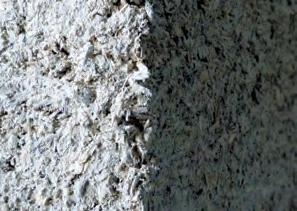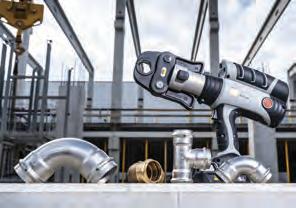
8 minute read
Building with hemp blocks Q&A
WHAT SHOULD CONSTRUCTION MANAGERS KNOW ABOUT BUILDING WITH HEMP? CM ASKS WILLIAM STANWIX FROM THE HEMP BLOCK COMPANY
What’s different with hemp compared to conventional building?
Advertisement
Hemp blocks are made from natural materials and the main difference is how they manage moisture.
Conventional housebuilding aims to eliminate moisture from the wall, using plastic vapour barriers internally and waterproof finishes externally. The danger with this is that if moisture does get into the wall, through poor detailing or construction, it gets trapped and can lead to mould and sick building syndrome.
Rather than eliminate moisture, natural materials manage moisture in a passive way. Natural materials are commonly described as breathable or, more accurately,
William Stanwix, Hemp Block Company
vapour or moisture permeable. This is similar to the difference between a rubber boot and a Gore-Tex boot. They both keep out external moisture but the Gore-Tex boot also allows the moisture from your sweaty feet to escape.
The consequence for your building (and this becomes more important as buildings become more airtight) is that a house built with natural hemp blocks relies far less on mechanical ventilation systems to manage internal moisture.
Because your wall is now vapour permeable your finishes also become vapour permeable to allow moisture out. Cement renders become lime renders, cement mortars become lime mortars and, as in conventional construction, timber or other cladding systems require a ventilated gap behind them.
What structure types are they typically used with?
Hemp blocks typically are paired with timber frame construction – stud frame or portal frame – but they can be used with a steel or concrete frame (although the steel would have to be painted to protect it from corrosion). With a stud frame, the blocks will make up part of or all of the wall build up.
With a portal frame – perhaps the simplest way of using them – you’d erect a portal feature oak or glulam frame. Then you’d wrap this with thick (300 or 400mm) hemp blocks.
In renovations, hempcrete blocks can replace wattle and daub panels, or you can put up a skin on the inside or outside of a solid walled property and use them as solid wall insulation.
What are the common pitfalls?
To make the most of hemp blocks, the designer needs to understand how they function.
Hemp blocks provide insulation, a backing for plasters and renders (no plasterboard required) and although they are not structurally load bearing, they do support their own self weight and that of the plaster or render. Despite this, it is not uncommon to see plasterboards specified with the blocks, or a vapour barrier on the internal side of the wall.
Because of the fundamental differences between hemp blocks and conventional construction, it is critical that they are considered and understood early on in a project. It is difficult to ‘shoehorn’ hemp blocks into an otherwise conventional build.
Is any specialist training required?
Anyone who can lay conventional blocks can lay hemp blocks. At most, they will need to be shown how to mix lime mortar.
Spec sheets are provided which detail types and numbers of wall ties as well as any other metal work that might be required. The main difference here being that all metalwork should be stainless steel or otherwise protected with paint as the lime can corrode other metals. Brick or block laying best practice guidelines (such as BS 5628-3:2005) are applicable in terms of protecting mortar from frost damage and excess heat or rain when laying.
Top: A house extension using hemp blocks with a timber stud frame in Dartmoor, Devon Below: Natural fibres in the hemp block


Partnership
In partnership with Viega
THE ADVANTAGES OF PRESS CONNECTION TECHNOLOGY
WELDING AND SOLDERING HAVE LONG BEEN THE PREFERRED MEANS FOR CONNECTING PIPES. BUT ADVANCEMENTS IN PRESS CONNECTION TECHNOLOGY HAVE ESTABLISHED THE TECHNIQUE AS A FASTER, SAFER AND MORE RELIABLE ALTERNATIVE
Speed and efficiency are key factors
that project managers must consider before proceeding with a chosen method for a project. Thanks to its straightforward process that requires little preparation, installing pipework using press connection technology can be up to 50% faster than a soldered connection.
Impressive time savings can also be seen when press connections are used in connecting thick-walled steel pipe, compared to welding. Independent laboratory testing with the Building Services Research and Information Association (BSRIA) compared the two methods, finding that where welding took 29 hours and 59 minutes to complete the assembly, Megapress press connections took just six hours and 38 minutes. This meant that the use of Viega’s Megapress system resulted in time savings of 78%.
Crucially, the speed of the press connection process does not come at the expense of reliability. Each connection is made through a machine press process – meaning there is no variation in the quality of each connection as the press tool ensures a uniform seal every time.
The press connection process is also far safer than traditional methods. Hot works, such as soldering and welding, can present a health and safety hazard. Welding fumes have recently been reclassified as a human carcinogen by the Health and Safety Executive (HSE).
With no heat involved, press connections present none of these risks. Ultimately, a safer working environment is assured when using press connection technology.
Viega press tools make two pressings simultaneously per connection – one in front of the sealing element and one behind it – making a strong, durable and torsional resistant connection. Should a connection be missed during the installation process, Viega fittings are equipped with SC-Contur – a dedicated leak path designed to deliver a clearly visible forced leakage across the entire pressure testing range – so any inadvertently missed connections can be immediately identified.
Considering the benefits offered by press connection systems, it is important to use the correct tool for the job. Pressgun 6 Plus is Viega’s
Above: Press connections create a uniform seal Top right: Viega’s Pressgun 6 Plus Below: The Pressgun 6 Plus in use on site latest model, offering an improved ergonomic design and equipped with a 360° infinitely rotatable jaw.
The Pressgun 6 Plus also features a built-in status indicator that also communicates to the Viega Tool Services app. With this functionality, the user can check safe operation, enable anti-theft protection, monitor the number of pressings they have made and view battery levels.
“At Viega we believe that the industry should work smarter, not harder,” says Scott James, managing director at Viega. “Huge advancements have been made to press connection technology in recent decades.
“In terms of efficiency, consistency and reliability, press connection far outperforms traditional techniques – not only massively reducing the installation time required but also offering certainty that each connection is totally uniform. Safer conditions on site are also assured, with no heat required during the process.
“Our ambition at Viega is to constantly bring products equipped with the latest innovative technology to market. The Pressgun 6 Plus is testament to that. This latest extension to our Pressgun range has been designed to deliver a higher level of performance than ever and, alongside the new digital connectivity, will provide unprecedented levels of user functionality.” ●
For more information on Pressgun 6 Plus, please visit: www.viega.co.uk.






‘MEMBERS ARE THE LIFEBLOOD’
THE CIOB’S NEW CEO CAROLINE GUMBLE TALKS TO CM
constructionmanagermagazine.com
CONSTRUCTION m ANAge R | j UN e 2020 | www. CONSTRUCTION m ANAge RmAgAz INe.CO m
CORONAVIRUS HOSPITALS
01.CMSept19.Cover.indd 1
OFFSITE MANUFACTURING SPECIAL | ISG’S BREWERY REBUILD | PRODUCTIVITY SURVEY
20/08/2019 15:38 01.CMJune20.Coverfinal.indd 1
constructionmanagermagazine.com


TeSTInG TIMeS
THe PROjeCT TeAmS wHO BUILT THe COVID HOSPITALS
CONSTRUCTION MANAGER | NOVEMBER/DECEMBER 2019 | WWW.CONSTRUCTIONMANAGERMAGAZINE.COM
LINCOLN CATHEDRAL
eMBODIeD CARBOn | WInVIC’S SMART SenSORS | AnnuAL BIM SuRVeY
19/05/2020 12:27 01.CMNovDec19.Coverfinal.indd 1
CONSTRUCTION MANAGER | FEBRUARY 2020 | WWW.CONSTRUCTIONMANAGERMAGAZINE.COM
WANDSWORTH RECLADDING
01.CMFeb20.Cover.indd 1
constructionmanagermagazine.com
GOLDEN GLOW
LASER GUNS HELP LINCOLN CATHEDRAL’S CONSERVATION
CONSTRUCTION MANAGER | JANUARY 2020 | WWW.CONSTRUCTIONMANAGERMAGAZINE.COM
GLEEDS CEO PROFILE
constructionmanagermagazine.com
READY FOR THE DIGITAL DISRUPTORS
GLEEDS CEO GRAHAM HARLE ON ADAPTING TO A FAST-CHANGING INDUSTRY
MCALPINE CEO PROFILE | STRUCTURAL STEEL SPECIAL | BIM STANDARDS CPD
21/10/2019 15:07
FEBRUARY 2020 For members of the CIOB
constructionmanagermagazine.com
CLAD TIDINGS
ONE LOCAL AUTHORITY’S RECLADDING CHALLENGE
01.CMJan20.Cover.indd 1
CONSTRUCTION MANAGER | MARCH 2020 | WWW.CONSTRUCTIONMANAGERMAGAZINE.COM
ETHNIC MINORITIES IN CONSTRUCTION
CONSTRUCTION’S FAIREST PAYERS | WILLMOTT DIXON’S PILGRIMAGE | HS2 ENABLING WORKS
MARCH 2020 For members of the CIOB
constructionmanagermagazine.com
THE CHANGING FACE OF CONSTRUCTION
HOW ETHNIC MINORITIES FEEL ABOUT WORKING IN THE INDUSTRY
3D MODELS FOR FIRE SAFETY | GRAHAM CEO PROFILE | PRECAST CONCRETE HOUSING
20/01/2020 12:04 01.CMMar20.Coverfinal.indd 1
TURNER & TOWNSEND MD PROFILE | LANDSEC’S NEW OFFICE CONCEPT | MODULAR TIMBER HOMES
30,887*
The largest circulation of any UK construction magazine.
Email newsletters reaching CIOB members and other construction professionals. Unparalleled access to the key decision makers leading the UK construction industry. *ABC audited July 2019 to June 2020










